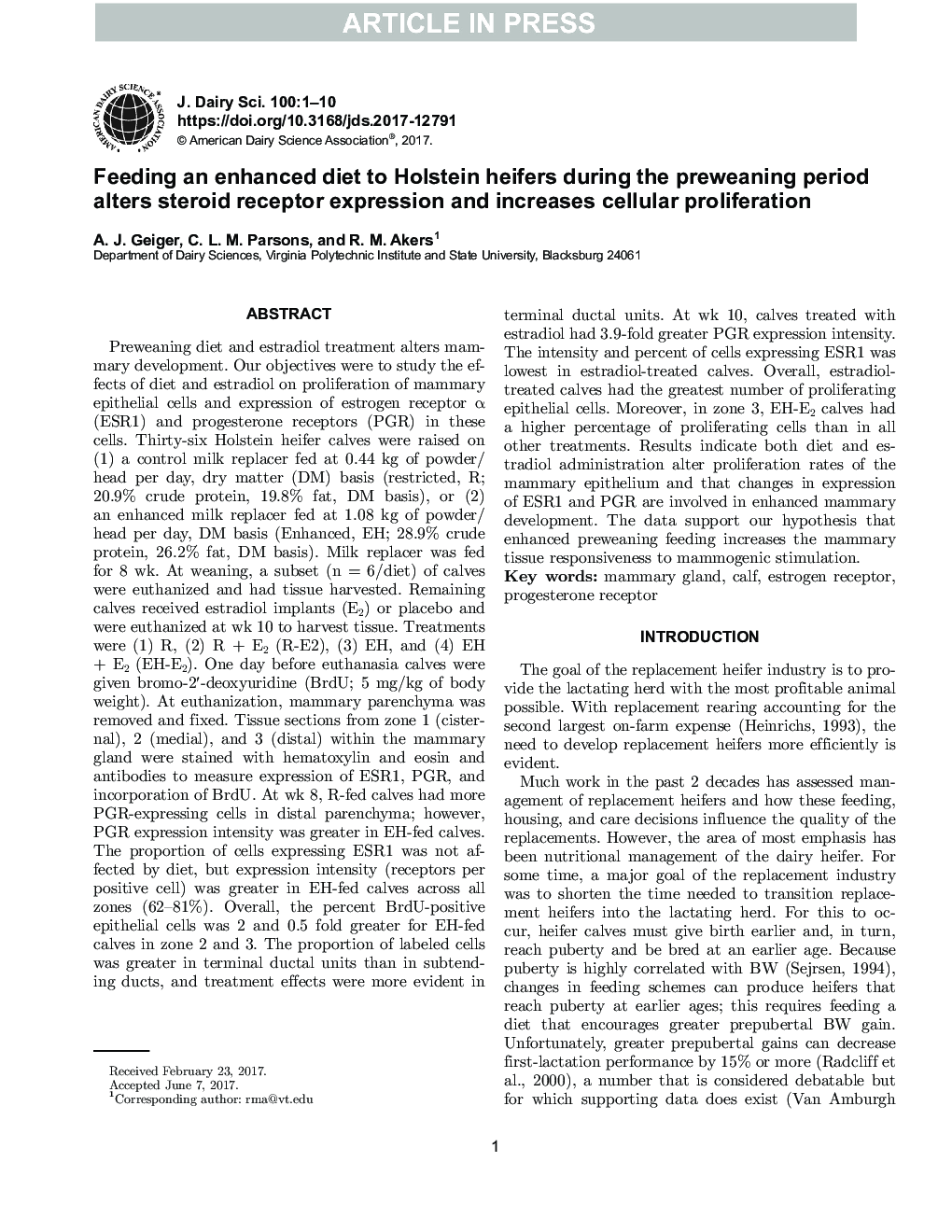| کد مقاله | کد نشریه | سال انتشار | مقاله انگلیسی | نسخه تمام متن |
|---|---|---|---|---|
| 5542039 | 1402513 | 2017 | 10 صفحه PDF | دانلود رایگان |
عنوان انگلیسی مقاله ISI
Feeding an enhanced diet to Holstein heifers during the preweaning period alters steroid receptor expression and increases cellular proliferation
ترجمه فارسی عنوان
تغذیه یک رژیم غذایی تقویت شده برای تلیسه های هلشتاین در طول دوره پیش از زایمان، بیانگر گیرنده استروئیدی را تغییر می دهد و باعث افزایش سلول های تکثیر می شود
دانلود مقاله + سفارش ترجمه
دانلود مقاله ISI انگلیسی
رایگان برای ایرانیان
کلمات کلیدی
غده پستانی، گوساله، گیرنده استروژن، گیرنده پروژسترون،
موضوعات مرتبط
علوم زیستی و بیوفناوری
علوم کشاورزی و بیولوژیک
علوم دامی و جانورشناسی
چکیده انگلیسی
Preweaning diet and estradiol treatment alters mammary development. Our objectives were to study the effects of diet and estradiol on proliferation of mammary epithelial cells and expression of estrogen receptor α (ESR1) and progesterone receptors (PGR) in these cells. Thirty-six Holstein heifer calves were raised on (1) a control milk replacer fed at 0.44 kg of powder/head per day, dry matter (DM) basis (restricted, R; 20.9% crude protein, 19.8% fat, DM basis), or (2) an enhanced milk replacer fed at 1.08 kg of powder/head per day, DM basis (Enhanced, EH; 28.9% crude protein, 26.2% fat, DM basis). Milk replacer was fed for 8 wk. At weaning, a subset (n = 6/diet) of calves were euthanized and had tissue harvested. Remaining calves received estradiol implants (E2) or placebo and were euthanized at wk 10 to harvest tissue. Treatments were (1) R, (2) R + E2 (R-E2), (3) EH, and (4) EH + E2 (EH-E2). One day before euthanasia calves were given bromo-2â²-deoxyuridine (BrdU; 5 mg/kg of body weight). At euthanization, mammary parenchyma was removed and fixed. Tissue sections from zone 1 (cisternal), 2 (medial), and 3 (distal) within the mammary gland were stained with hematoxylin and eosin and antibodies to measure expression of ESR1, PGR, and incorporation of BrdU. At wk 8, R-fed calves had more PGR-expressing cells in distal parenchyma; however, PGR expression intensity was greater in EH-fed calves. The proportion of cells expressing ESR1 was not affected by diet, but expression intensity (receptors per positive cell) was greater in EH-fed calves across all zones (62-81%). Overall, the percent BrdU-positive epithelial cells was 2 and 0.5 fold greater for EH-fed calves in zone 2 and 3. The proportion of labeled cells was greater in terminal ductal units than in subtending ducts, and treatment effects were more evident in terminal ductal units. At wk 10, calves treated with estradiol had 3.9-fold greater PGR expression intensity. The intensity and percent of cells expressing ESR1 was lowest in estradiol-treated calves. Overall, estradiol-treated calves had the greatest number of proliferating epithelial cells. Moreover, in zone 3, EH-E2 calves had a higher percentage of proliferating cells than in all other treatments. Results indicate both diet and estradiol administration alter proliferation rates of the mammary epithelium and that changes in expression of ESR1 and PGR are involved in enhanced mammary development. The data support our hypothesis that enhanced preweaning feeding increases the mammary tissue responsiveness to mammogenic stimulation.
ناشر
Database: Elsevier - ScienceDirect (ساینس دایرکت)
Journal: Journal of Dairy Science - Volume 100, Issue 10, October 2017, Pages 8534-8543
Journal: Journal of Dairy Science - Volume 100, Issue 10, October 2017, Pages 8534-8543
نویسندگان
A.J. Geiger, C.L.M. Parsons, R.M. Akers,
